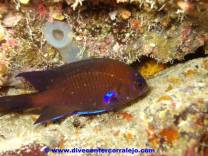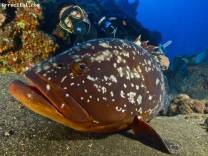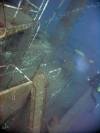
The Canary Islands are Europe's best bet for warm water scuba diving.
Take a look at all the pictures!
Recent diving activity from our members
Sardina del Norte is a road trip from the south of just over an hour. But there are two good reasons to dive there once ...
Green Garden is nice dive site on top of some hard and soft corals in general green of color.
- Faro
- Cabras
The max depth of this divesite is 40 (if you want)! At 40 meters starts black coral....
- Caves and Tunnels: These are nice...
Playa del Ingles, Maspalomas and Meloneras are the most popular tourist areas on Gran Canaria, because of the dunes and ...
- Wrecks of Mog: Just outside the harbor at Mogan are two small wre...
- Russian Wreck El Pajar: El Pajar is the wreck of a 30m long Russian hydrof...
The Canary Islands, a province of Spain, consists out of seven main islands, all with their own characteristics and highlights. At only one hundred kilometers west of Marocco, they benefit from the warm winds coming from the Sahara and have a mild sea climate with temperatures between twenty and thirty degrees year around. These warm temperatures have made the Canary Island highly popular for senior citizens in Europe and many travelers escaping from the cold winter. Tourists that like beaches, shopping, surfing and other water activities, but also mountain bikers and hikers, will have the time of their life here. The Canary Islands were the last pieces of land for Christopher Columbus on its journey to America. Other cultural heritage has come from historic Spanish architecture and craftsmanship. For the rest it is sun, warmth, beaches, promenades, bars, relaxing or joining in one of the many water and land activities such as surfing, kite boarding, scuba diving, sailing, hiking or biking. Its volcanic history offers excellent rock formations, arches, volcanic cones and craters and some of the quickest changing environments on earth. You can be camel riding in a desert, walking on the steep mountain slopes, hiking dense, wet and green forests or enjoying some views across the Atlantic Ocean from the top of the island. Playing golf in the Canary Islands is also highly popular.
From east to west the islands include Lanzarote, Fuerteventura, Gran Canaria, Tenerife, Gomera, La Palma and El Hierro. The two islands closest to Africa are Lanzarote and Fuerteventura and both have a very different climate than the other islands. Timanfaya National Park at Lanzarote is a dry and barren island with many volcanic cones and craters. Fuerteventura looks like the Sahara desert dropping down in the ocean. Corralejo, Isla de Lobos and Morro Jable are the main tourist resorts where diving is very popular. The two most populated islands Tenerife and Gran Canaria have both received a provincial capital after a huge quarrel about it. Highlights of Gran Canaria are the Dunes of Maspalomas while that of Tenerife is the highest mountain and volcano El Teide that sets the skyline wherever you go. La Gomera with its beautiful capital San Sebastian is much greener and very popular for hikers. El Hierro is home to one of the few reserves on the Canary Islands. Near the town of La Restinga you will find the Mar de las Calmas which is a haven for scuba divers and considered to be one of the best places for scuba diving. La Palma has resorts at Los Cancajos and Puerto Naos while Parque Nacional de la Caldera offers some excellent pine and laurel forests. So it doesn't matter which way you go. They are all prepared for tourism and all have some excellent getaway destinations for young and old.
Water temperatures hover between 17 and 24 degrees Celsius bordering rocky volcanic white and black sanded beaches. Three to five millimeter wetsuits are normal while some dive schools offer dry suits during the winter. Its underwater environment consists of rocky slopes, some gradually descending but others dropping down to steep walls. There are arches, caves, caverns, swimmthroughs and chimneys, all formed because of volcanic lava flows years and years ago. Marine life can consist of huge pelagic species and game fish but also coral fish and the common reef fish are ever present. The Sea of Calmes is with it slightly warmer waters than elsewhere and calm conditions one of the top destinations for diving, but each island has its favorite dive sites, which are worth diving to.























